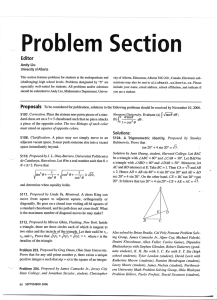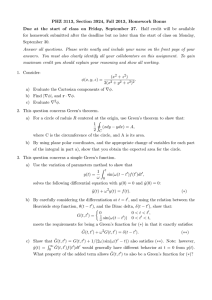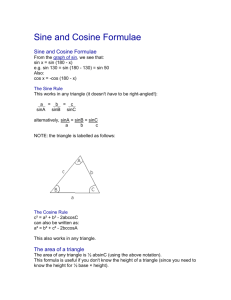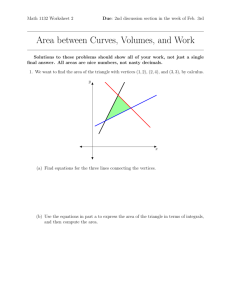Problem Solving (MA2201) Week 4
advertisement
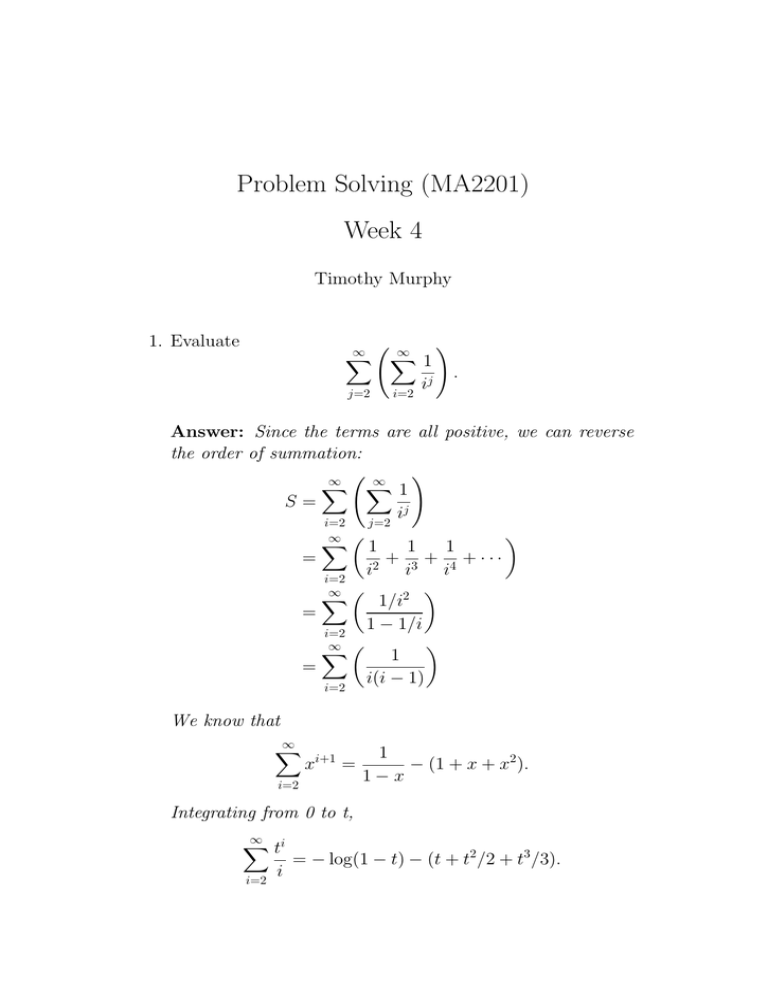
Problem Solving (MA2201)
Week 4
Timothy Murphy
1. Evaluate
∞
∞
X
X
1
ij
j=2
i=2
!
.
Answer: Since the terms are all positive, we can reverse
the order of summation:
!
∞
∞
X
X
1
S=
ij
j=2
i=2
∞ X
1
1
1
=
+ 3 + 4 + ···
2
i
i
i
i=2
∞ X
1/i2
=
1 − 1/i
i=2
∞ X
1
=
i(i − 1)
i=2
We know that
∞
X
xi+1 =
i=2
1
− (1 + x + x2 ).
1−x
Integrating from 0 to t,
∞ i
X
t
i=2
i
= − log(1 − t) − (t + t2 /2 + t3 /3).
Integrating this from 0 to x,
∞
X
xi−1
= ((1−x) log(1−x))+x)−(x2 /2+x3 /6+x4 /12)
i(i − 1)
i=2
Setting x = 1,
S=
∞
X
i=2
1
i(i − 1)
= 1 − (1/2 + 1/6 + 1/12)
= 1/4,
2. The point P lies inside the square ABCD. If |AP | = |BP |
and AB̂P = 15◦ , show that the triangle CP D is equilateral.
Answer: Let us draw an equilateral triangle CP D (pointing into the square). Then
B ĈP = π/2 − P ĈD = π/2 − π/3 = π/6.
Let
AB̂P = x.
Then
C B̂P = π/2 − x.
Now
CP = CD = CB.
Thus the triangle CP B is isosceles. Hence
C B̂P = C P̂ B = π/2 − x.
So from the triangle BCP ,
2(π/2 − x) + π/6 = π,
ie
AB̂P = x = π/12 = 15◦ .
Conversely, if we start with AB̂P = 15◦ then we obtain an
equilateral triangle CP D.
3. Construct an infinite non-constant arithmetic sequence of
positive integers which contains no squares, cubes or higher
powers of integers.
Answer: Let p be a prime. Consider the arithmetic sequence
a(n) = p + np2
for n = 1, 2, . . . .
Since p | a(n) for all n, if a(n) is a square or higher power
then
p2 | a(n),
which is not the case since
a(n) ≡ p mod p2 .
4. Show that the number of ways of making up n cents from
(n + 4)2
.
1c, 2c and 5c pieces is the nearest integer to
20
Answer: Although it is possible to solve this question using
generating series, it turns out to be much easier to prove it
using induction.
Let the number of ways of making n cents from 1c, 2c and
5c coins be a(n); and let the number of ways of making n
cents just from 1c and 2c coins be b(n). Evidently
b(n) = |n/2| + 1.
We can divide the ways of making up n cents in two; those
that only use 1c and 2c coins, and those that use at least
one 5c coin.
In the second case, if we remove one 5c coin there are a(n−
5) ways of making up the remaining sum.
Thus
a(n) = a(n − 5) + b(n).
Applying the same argument again,
a(n) = a(n − 10) + b(n) + b(n − 5)
= a(n − 10) + |n/2| + 1 + |(n − 5)/2| + 1.
If n is even then n − 5 is odd, and
|n/2| + |(n − 5)/2| = n/2 + (n − 6)/2 = n − 3.
Similarly, if n is odd then n − 5 is even, and
|n/2| + |(n − 5)/2| = (n − 1)/2 + (n − 5)/2 = n − 3,
as before. Thus in all cases
a(n) = a(n − 10) + (n − 1).
Replacing n by n + 10,
a(n + 10) = a(n) + (n + 9).
Now let
f (n) = (n + 4)2 /20 = (n2 + 8n + 16)/20.
We have
f (n + 10) = (n + 4 + 10)2 /20
= (n + 4)2 /20 + 20(n + 4)/20 + 100/20
= f (n) + n + 4 + 5
= f (n) + 9.
Thus the fractional parts of f (n) and f (n + 10) are the
same; and the closest integers differ by 9, like a(n) and
a(n + 10).
It follows that if the result holds for some n (ie a(n) is equal
to the nearest integer to f (n)) then the same will be true
for n + 10, n + 20, . . . .
Thus to prove the result for all n, it is sufficient to verify
it for 1 ≤ n ≤ 10.
We summarise this in a table:
n
1
2
3
4
5
6
7
8
9
10
a(n)
1
2
2
3
4
5
6
7
8
10
(n + 4)2 /20
1.25
1.8
2.45
3.2
4.05
5.0
6.05
7.2
8.45
9.8
We see that in all these cases a(n) is indeed the nearest
integer to f (n). Hence the result holds for all n ≥ 1.
5. For which positive real numbers x does the sequence
x
x, xx , xx , . . .
converge?
Answer: We are dealing with the sequence a(0), a(1), . . .
defined by
a(n + 1) = xa(n) ,
with a(0) = 1.
Suppose
a(n) → `
as n → ∞. Then
a(n + 1) → x` .
Hence
x` = `,
ie
x = `1/` .
Consider the function
f (t) = t1/t
for t > 0.
We have
log f (t) =
log t
,
t
and so
f 0 (t) =
1 − log t
.
t2
Thus
f 0 (t) = 0
when t = e and
f (e) = e1/e .
Since
log f (t) → −∞
as t → 0 (from above), it follows that
f (t) → 0 as t → 0
On the other hand,
log f (t) → 0
as t → ∞, and so
f (t) → 1 as t → ∞.
Hence f (t) increeases from 0 to e1/e as t increases from 0
(or near 0) to e and then decreases to 1 as t increase to ∞.
It follows that a(n) is not convergent if x > e1/e .
If 0 < x < 1 then
a < 1 =⇒ ax < a.
It follows that a(n) is decreasing, and so converges.
If x = 1 then a(n) = 1 for all n, and so a(n) → 1.
If x > 1 then
a > 1 =⇒ ax > a.
Hence a(n) is increasing, and so converges or tends to ∞.
We know that a(n) diverges if x > e1/e . It remains to
determine the outcome if 1 < x ≤ ` = e1/e .
If 1 < a ≤ ` and x ≤ ` then
ax ≤ `` = `.
Hence a(n) is bounded above, and so converges.
Thus a(n) converges if and only if 0 < x ≤ e1/e .
6. Show that if a pentagon ABCDE inscribed in a circle has
equal angles then it has equal sides.
Answer: Let O be the centre of the circle; and let
OÂB = x.
Then
OB̂A = x,
since OAB is isosceles.
The sum of the angles in the pentagon is 5π − 2π = 3π.
Thus each of the angles is 3π/5. In particular
3
AB̂C = π.
5
Hence
3
OB̂C = AB̂C − OB̂A = π − x.
5
7. Does there exist a function f : N → N such that
f (f (n)) = n + 1
for all n?
Answer: The answer is No. For such a map f must commute with
g(n) = n + 1,
since
f ◦ g = f ◦ (f ◦ g) = (f ◦ f ) ◦ f = g ◦ f.
But it is easy to see that the only maps h : Z → Z which
commute with g are the powers of g, ie
h(n) = g r (n) = n + r
for r ∈ Z. For if
h(0) = r
then
h(1) = h(g(0)) = g(h(0)) = h(0) + 1 = r + 1,
h(2) = h(g(1)) = g(h(1)) = h(1) + 1 = r + 2,
and so on, while
g(h(−1)) = h(g(−1)) = h(0) = r,
id
h(−1) + 1 = r =⇒ h(−1) = r − 1,
and so on.
Thus
f (n) = n + r
for some r, and so
f (f (n)) = n + 2r,
which cannot be g(n) = n + 1.
8. Let p(x) be the polynomial of degree n such that
p(k) =
k
,
k+1
k = 0, 1, 2, . . . , n.
Find p(n + 1).
Answer: Let
f (x) = 1 − p(x).
Then
f (k) =
1
,
k+1
k = 0, 1, 2, . . . , n.
Now let
g(x) = f (x + 1)
Then
1
g(k) = ,
k
k = 1, 2, 3, . . . , n + 1.
Let
h(x) = xg(x)
Then
h(k) = 1,
k = 1, 2, 3, . . . , n + 1.
Also,
h(0) = 0.
Thus
h(x) − 1
is a polynomial of degree n+1 with zeros at 1, 2, 3, . . . , n+1.
It follows that
h(x) − 1 = c(x − 1)(x − 2) · · · (x − (n + 1))
for some constant c. Since h(0) = 0,
c = (−1)n /(n + 1)!.
Thus
h(x) = 1 + (−1)n (x − 1)(x − 2) · · · (x − (n + 1))/(n + 1)!.
Hence
h(n + 2) = 1 + (−1)n
(
2 if n is even
=
0 if n is odd
So
(
2/(n + 2) if n is even
f (n + 1) = g(n + 2) =
0 if n is odd
and finally
p(n + 1) = 1 − f (n + 1) =
(
n/(n + 2) if n is even
1 if n is odd
9. Does the number 2011n end in the digits 2011 for any integer n > 1?
Answer: Yes.
Since 2011 is coprime to 104 , 2011 is an element of the
finite group (Z/104 )× , and so has finite order d:
2011d ≡ 1 mod 10000,
ie 2011d ends in 10001. Hence
2011d+1 ≡ 2011 mod 10000,
ie 2011d+1 ends in the digits 2011.
10. Does the number 2011n start with the digits 2011 for any
integer n > 1?
Answer: Yes.
2011n begins with 2011 if
2011 · 10m ≤ 2011n < 2012 · 10m
for some natural number m. In other words,
2012 m
10 .
2011
Taking logarithms to base 10, this is equivalent to
10m ≤ 2011n−1 <
m ≤ (n − 1) log 2011 < m + log 2012/2011.
Let {x} denote the ‘fractional part’ of x, ie
{x} = x − [x].
We have to show that some integral multiple of log 2011 has
small fractional part.
This is a general result: given any α ∈ R and any > 0 we
can find an n ∈ N such that
{nα} < .
This is proved using the Pigeon-hole Principle. Choose N
so that
N > 1,
and consider the N + 1 fractional parts
0, {α}, {2α}, {3α}, . . . , {N α}.
11. If A, B, C are the angles of a triangle, what is the maximal
value of
A
B
C
sin sin sin ,
2
2
2
and when is it attained?
Answer: Since the function is continuous, its maximum is
attained at some point inside the triangle.
Keeping C fixed,
sin(A/2) sin(B/2) = cos(A/2 − B/2) − cos(A/2 + B/2)
= cos(A/2 − B/2) − sin(C/2),
since (A + B)/2 = π/2 − C/2.
Thus at a maximum
A = B.
Similarly
A = C.
Thus the maximum is attained where
A = B = C = π/3.
Since
sin(π/6) = 1/2
the maximal value is 1/8.
12. S is a sphere with centre O. Given any point P outside
S let S 0 be the sphere with centre P passing through O.
Show that the area of that part of the surface of S 0 lying
inside S is independent of P .
Answer: We use the theorem, due to Archimedes, that the
surface area of the slice of a sphere cut off by a plane is
equal to the corresponding area of the enclosing cylinder.
Take a plane through OP , and let the circle S ∩ S 0 intersect
this plane in Q, R. If QR meets OP in T then the theorem
tells us that the surface area of S 0 inside S is
A = 2πOP · OT.
We have to show that this does not depend on P .
The two right-angled triangles OQT and OP Q are similar.
Hence
OT
OQ
=
.
OQ OP
Thus
OP · OT = OQ2 = r2 ,
where r is the radius of S. In particular, OP · OT is independent of P .
13. A piece is broken off each of 3 equal rods at random. What
is the probability that these 3 pieces form a triangle?
Answer: We can suppose the rods have length 1 (since
this is just a matter of choosing a unit of length). Suppose
pieces of lengths x, y, z are broken off the 3 rods. These will
form a triangle if and only if
x ≤ y + z, y ≤ x + z, z ≤ x + y.
The values of x, y, z are distributed evenly over the unit cube
I 3 . Thus the required probability is just the volume of the
region
S = {(x, y, z) ∈ I 3 : x ≤ y + z, y ≤ x + z, z ≤ x + y}.
Since
I 3 \ S = Sx ∪ Sy ∪ Sz ,
where Sx , Sy , Sz are the 3 disjoint sets
Sx = {(x, y, z) ∈ I 3 : x > y+z}, Sy = {(x, y, z) ∈ I 3 : y > x+z}, Sz = {(x, y
the probability is
1 − 3kSx k.
Now Sx is the tetrahedron with vertices
(0, 0, 0), (1, 1, 0), (1, 0, 1), (1, 1, 1).
The first 3 of these lie in the√plane x = y + z, forming an
equilateral triangle with side 2. The 4th point is distance
|1 − 1 − 1|
√
3
from the plane. Thus the volume of Sx is
√
1 1√ 3 1
1
2√ √ = .
32
2 3 6
It follows that the probability of the pieces forming a triangle
is
1 1
1−3 = .
6 2
14. The points P1 , . . . , Pn lie on the surface of a sphere of radius
r. Show that the distance between the 2 closest points is
√
< 4r/ n.
Answer: Suppose the smallest distance between 2 points is
d. Let α the angle for which
d
r sin α = .
2
Draw a circle radius d/2 around each of the points Pi , ie
the circle formed by the points P such that P Pi subtends
angle α at the centre of the sphere.
Then these circles—or rather the areas on the surface of
the sphere inside these circles—will not overlap. For if the
circles around Pi and Pj overlap then
Pi OPj ≤ 2α,
from which it follows that
|Pi Pj | ≤ 2r sin α = d.
The area of each circle is
π(r sin α)2 ,
so the area inside each circle on the sphere is larger than
this. Since the circles do not overlap, their total area is less
than the area of the sphere, ie
nπ(r sin α)2 ≤ 4πr2 .
Thus
n(d/2)2 ≤ 4r2 ,
from which the result follows.
15. Suppose A and B are two different n × n matrices with real
entries. If A3 = B 3 and A2 B = B 2 A, show that A2 + B 2
cannot be invertible.
Answer: Since
(A2 + B 2 )(A − B) = (A3 − B 3 ) − (A2 B − B 2 A) = 0,
while A − B 6= 0, it follows that A2 + B 2 is singular. (If v
is a non-zero column of A − B then (A2 + B 2 )v = 0.)
Challenge Problem
Alice and Bob play the following game on an infinite square
grid: taking turns, they paint the sides of the squares, Alice in
red and Bob in blue. The same side cannot be painted twice.
Alice plays first. Show that Bob can prevent Alice completing
a closed red contour.
Answer:
![Math 131 Practice Exam 3 on [ -1, 4].](http://s2.studylib.net/store/data/010538103_1-a851ef52d08f89241a99ddd9d94bbb2a-300x300.png)

